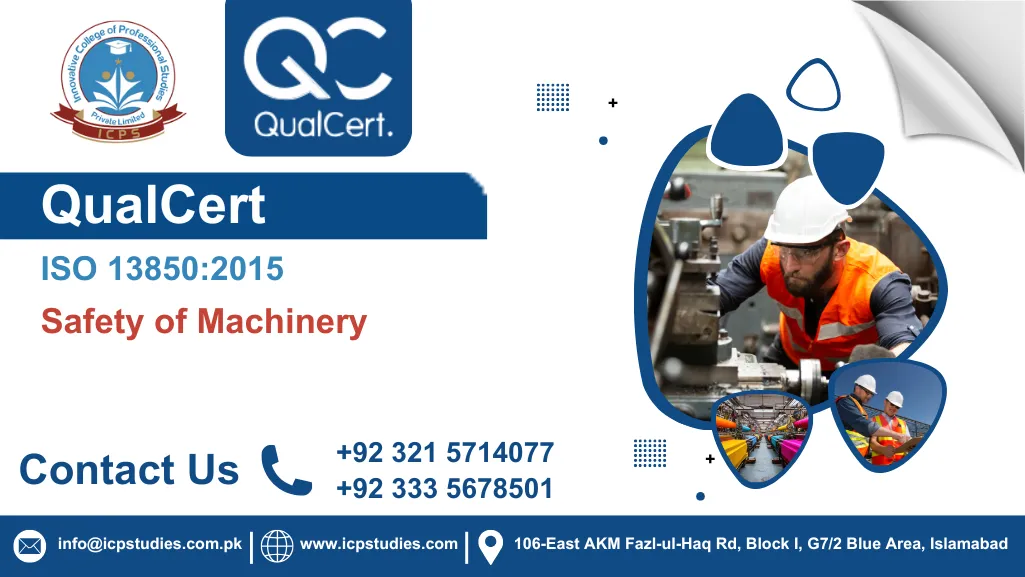The QualCert ISO 13850:2015 Safety of Machinery course has been carefully designed to provide learners with a comprehensive understanding of the international standard that governs the design and application of emergency stop functions in machinery. This standard is critical in ensuring that operators can immediately halt equipment during hazardous situations, thereby preventing accidents and safeguarding workplace safety. The course introduces participants to the principles behind ISO 13850:2015, the rationale for its requirements, and the importance of integrating emergency stop functions into machinery design and operation. By combining theoretical knowledge with practical application, learners will gain the skills needed to interpret the standard and apply it confidently across industrial environments.
Throughout the program, learners will explore the technical definitions, compliance obligations, and safety considerations that underpin ISO 13850:2015. The training emphasizes how emergency stop functions contribute to overall machinery safety and how organizations can implement them to meet international best practices. Case studies, industry examples, and scenario‑based exercises are used to highlight the relevance of the standard in real‑world contexts, ensuring that learners can connect regulatory requirements with practical workplace solutions. This structured approach not only builds competence but also reinforces the importance of proactive safety management in manufacturing, engineering, and maintenance operations.
The QualCert ISO 13850:2015 Safety of Machinery course is not Ofqual regulated, but successful learners will receive certification from QualCert, which serves as a valuable credential in professional development. This certification can complement other industry‑recognized diplomas and certificates in occupational safety, engineering, and risk management, strengthening a learner’s portfolio and employability. For professionals committed to advancing their expertise in machinery safety, this course provides a strong foundation for applying international standards, supporting compliance, and contributing to safer, more efficient workplaces.
All About QualCert ISO 13850:2015 Safety of Machinery
Course Overview
The QualCert ISO 13850:2015 Safety of Machinery is a 30‑credit qualification designed to provide learners with a structured and comprehensive understanding of emergency stop functions in machinery. With a Total Qualification Time (TQT) of 180 hours, including 120 Guided Learning Hours (GLH), the program ensures a balanced approach between guided instruction and independent study. This framework allows learners to build both theoretical knowledge and practical competence, ensuring they can interpret and apply the requirements of ISO 13850:2015 effectively in diverse industrial contexts.
This program is meticulously crafted to deliver focused and efficient skill development in the field of machinery safety. Learners will explore the principles behind emergency stop functions, their critical role in preventing accidents, and the technical requirements outlined in the standard. By combining regulatory knowledge with practical application, the course equips participants to evaluate compliance, recommend improvements, and implement safety measures that align with international best practices. The structured learning hours provide a strong foundation, while independent study encourages deeper reflection and mastery of the subject matter.
A distinctive feature of this qualification is its emphasis on real‑world application. Learners will engage with case studies, industry examples, and scenario‑based exercises that highlight the importance of ISO 13850:2015 in everyday operations. This approach ensures that participants not only understand the technical requirements but also develop the ability to apply them effectively in manufacturing, engineering, and maintenance environments. The program fosters analytical thinking, problem‑solving, and practical awareness, making it highly relevant for professionals seeking to strengthen their expertise in machinery safety and compliance.
Upon successful completion, learners will receive certification from QualCert, demonstrating their achievement and commitment to professional development in this specialized area. While not Ofqual regulated, the qualification holds significant value as a recognized credential that can complement other industry‑related diplomas and certificates in occupational safety, engineering, and risk management. The QualCert ISO 13850:2015 Safety of Machinery course therefore provides a strong foundation for career progression, reinforcing professional credibility and supporting safer, more efficient workplace practices.
To enroll in the QualCert ISO 13850:2015 Safety of Machinery course, learners are expected to meet the following criteria:
- Age Requirement: Learners should normally be 18 years or older to ensure maturity and readiness for professional-level study.
- Educational Background: A minimum of secondary education is recommended. Learners with prior diplomas or certificates in occupational safety, mechanical engineering, industrial technology, or risk management will find this course particularly beneficial. Related qualifications such as workplace safety diplomas, engineering certificates, or compliance-focused awards provide a strong foundation.
- Language Proficiency: Proficiency in English is required, as all course materials, assessments, and discussions are delivered in English. Clear communication skills are essential for interpreting technical standards and applying them effectively.
- Work Experience: While not mandatory, prior experience in engineering, manufacturing, maintenance, or safety management is advantageous, as it allows learners to contextualize the requirements of ISO 13850:2015 within real-world operations.
This qualification is designed to be accessible yet rigorous, ensuring that learners with the right educational background and professional interest can successfully engage with the material and apply it to their workplace practices.
The ideal learner for the QualCert ISO 13850:2015 Safety of Machinery course is someone committed to advancing their expertise in machinery safety, compliance, and workplace risk management. This profile reflects the skills, interests, and professional attributes that align with the demands of the program.
Professional Orientation
- Works in manufacturing, engineering, maintenance, or occupational safety roles
- Seeks to strengthen knowledge of international safety standards
- Values compliance and operational efficiency in industrial settings
- Interested in applying technical standards to practical workplace scenarios
- Motivated to enhance career progression through recognized certification
Technical Competence
- Familiar with machinery operations and mechanical systems
- Understands basic engineering principles and workplace safety practices
- Able to interpret technical documents and apply them to real-world contexts
- Comfortable with measurements, risk assessments, and compliance checks
- Keen to develop advanced skills in hazard identification and prevention
Learning Approach
- Demonstrates strong analytical and problem-solving skills
- Engages actively with structured learning and guided instruction
- Balances independent study with collaborative learning opportunities
- Applies theoretical knowledge to practical case studies and examples
- Values continuous professional development and lifelong learning
Communication Skills
- Proficient in English for reading, writing, and discussion
- Capable of presenting safety recommendations clearly and effectively
- Skilled in documenting compliance processes and reporting findings
- Able to collaborate with colleagues across technical and safety teams
- Appreciates the importance of clear communication in risk management
Commitment to Safety
- Prioritizes worker health and safety in all professional activities
- Understands the ethical responsibility of ensuring safe machinery use
- Seeks to reduce workplace accidents through proactive measures
- Values international standards as benchmarks for safety excellence
- Dedicated to promoting a culture of safety within organizations
Career Development Goals
- Aspires to strengthen professional credibility in safety and engineering fields
- Seeks certification that complements existing diplomas or certificates
- Interested in roles requiring compliance expertise and technical safety knowledge
- Motivated to contribute to organizational safety audits and inspections
- Committed to building a portfolio of recognized qualifications
The ideal learner is therefore someone who combines technical interest, professional ambition, and a strong commitment to workplace safety. This course provides them with the knowledge and certification to advance th
Study Units
- Emergency Stop Functions and Their Importance
- Design and Implementation of Safety Circuits
- Testing and Validation of Emergency Stop Systems
- Human-Machine Interaction and Response Mechanisms
- ISO 13850 Compliance and Global Safety Regulations
- Maintenance and Troubleshooting of Emergency Stop Systems
Learning Outcomes
By the end of this qualification, learners will have developed a comprehensive understanding of emergency stop functions, safety circuit design, testing and validation, human-machine interaction, compliance requirements, and maintenance practices. Each unit is carefully structured to build technical knowledge, practical competence, and professional awareness, ensuring learners can apply ISO 13850:2015 effectively in diverse industrial contexts.
Emergency Stop Functions and Their Importance
- Explain the critical role of emergency stop functions in machinery safety and hazard prevention.
- Identify different types of emergency stop devices and their specific applications across industries.
- Understand operational principles and safety requirements for emergency stop systems.
- Recognize scenarios where emergency stop functions are essential for hazard mitigation and accident reduction.
- Evaluate how emergency stop devices contribute to overall workplace safety culture.
Design and Implementation of Safety Circuits
- Design safety circuits that integrate emergency stop functions effectively and reliably.
- Select appropriate components and technologies for constructing safety circuits.
- Apply best practices to ensure fail-safe operation of emergency stop systems.
- Document safety circuit designs to comply with industry standards and regulatory requirements.
- Recommend improvements to circuit design based on risk assessments and operational needs.
Testing and Validation of Emergency Stop Systems
- Develop structured test plans to validate the performance of emergency stop systems.
- Perform inspections and functional tests to verify reliability and compliance.
- Identify and address common faults or failures discovered during testing activities.
- Record and report test results to demonstrate compliance with ISO 13850 requirements.
- Establish continuous monitoring processes to ensure ongoing system effectiveness.
Human-Machine Interaction and Response Mechanisms
- Analyze how human factors influence the design and effectiveness of emergency stop devices.
- Evaluate response mechanisms to ensure rapid and safe machine stoppage.
- Optimize placement and accessibility of emergency stop devices for operator safety.
- Incorporate ergonomic principles to enhance operator interaction with safety controls.
- Assess user feedback to improve emergency stop usability and effectiveness.
ISO 13850 Compliance and Global Safety Regulations
- Interpret key requirements of ISO 13850:2015 related to emergency stop functions.
- Understand how global safety regulations impact emergency stop system design and application.
- Ensure emergency stop systems meet legal and regulatory compliance standards.
- Prepare documentation for audits, inspections, and certification processes.
- Monitor updates in international safety regulations to maintain compliance.
Maintenance and Troubleshooting of Emergency Stop Systems
- Implement regular maintenance procedures to ensure system integrity and reliability.
- Diagnose and troubleshoot common issues affecting emergency stop performance.
- Apply corrective actions to restore system functionality promptly.
- Develop maintenance logs and schedules aligned with safety standards.
- Promote continuous improvement in maintenance practices to enhance long-term safety.
These learning outcomes ensure that learners completing the QualCert ISO 13850:2015 Safety of Machinery course are equipped with the technical knowledge, practical skills, and compliance awareness necessary to uphold the highest standards of workplace safety. The program provides a strong foundation for professional growth, enabling participants to contribute meaningfully to safer, more efficient, and internationally compliant industrial environments.
FAQs About QualCert ISO 13850:2015 Safety of Machinery

